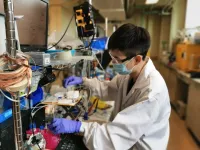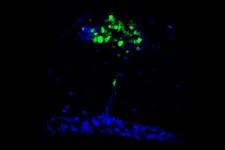(Press-News.org) Researchers from University of Toronto Engineering have developed an improved electrochemical system that raises the value of captured CO2 by converting more of it into valuable products than ever before.
The International Energy Agency recently cited carbon capture and storage as one of the strategies that can help keep global emissions low enough to limit global warming to 1.5 C by 2050. But captured carbon currently has little economic value, reducing the incentive for companies to invest in this technology.
A University of Toronto Engineering team led by Professor Ted Sargent is addressing this challenge by designing advanced electrolyzers that use electricity to convert captured CO2 into the petrochemical building blocks of common everyday materials, from plastic to lycra. This helps create a market for captured carbon, while also providing a low-carbon alternative to the fossil fuel-based manufacturing processes in use today.
Unlike previous systems, the team's latest design can be run under strongly acidic conditions, which reduces undesired side reactions and enhances overall efficiency.
"In previous systems, you had to choose whether to focus on efficient use of electricity, or efficient use of carbon," says Sargent, senior author of a new paper published today in Science. "Our team used a new catalyst design inside the electrolyzer to consume a large fraction of the input carbon, while keeping good productivity towards desirable high-value products."
In the electrolyzer, captured CO2 is dissolved in a liquid electrolyte, which flows over the solid catalyst through which the electricity is supplied.
"What we want is for the dissolved CO2 in the reactor to absorb electrons and get converted into ethylene and other products," says PhD candidate Jianan Erick Huang, one of three co-lead authors on the new paper along with fellow PhD candidate Adnan Ozden and postdoctoral fellow Fengwang Li, who is now continuing similar research at the University of Sydney.
"But, in prior reports which operated at high pH -- meaning alkaline or neutral conditions -- most of the CO2 is wasted, because it gets converted into carbonate instead."
Huang says that while the carbonate can be extracted, converted into CO2 and fed back into the electrolyzer, doing so is energetically costly. The team's calculations show that more than half of the energy consumed by the overall system would be spent on recycling the carbonate in this way.
Running the electrolyzer under low pH, or acidic conditions, prevents the formation of carbonate, but it introduces a different problem: now the more favourable reaction is hydrogen evolution. This means that hydrogen ions (i.e., protons) in the acidic solution absorb electrons and get converted to hydrogen gas, leaving few electrons available to combine with CO2.
Huang and the team dealt with this problem using two strategies in combination. First, under acidic conditions, they increased the current density, flooding the reactor with electrons. Hydrogen ions rushed in to react with them, but they got caught in a molecular traffic jam -- the technical term is mass transport limitation.
"In effect, we're creating a reactor that is acidic throughout, except for a tiny layer within less than 50 micrometres of the catalyst surface," says Huang. "In that specific region, it is not acidic, in fact it's slightly alkaline. There, CO2 can get reduced to ethylene by those electrons."
The next step was to add a positively charged ion, in this case potassium, to the reaction. This created an electric field near the catalyst that made it easier for CO2 to adsorb to the surface, giving it the edge in the competition with the hydrogen.
The two changes made a big difference. Previous systems had typically utilized less than 15% of the available carbon, losing the rest to carbonate. The new system utilizes about 77% of available carbon, with more than 50% being converted to multi-carbon products such as ethylene and ethanol. (The other 27% goes to single-carbon products such as carbon monoxide and formic acid.)
"This breakthrough helps pave the way forward to an economically viable?future for CO2 utilization?even with high CO2 capture costs today," says Dr. Philip Llewellyn, Carbon Capture and Utilization (CCUS) Manager for TOTAL SE, which provided financial support for the research. "When one further considers the projected?increases in carbon tax needed?to meet global climate targets, this represents a significant acceleration in the time-to-market and time-to-climate impact for CO2 electrolyzers."
There are still hurdles to be overcome before this system can be scaled up to an industrial level, including the stability of the catalyst when its size is increased and the need for even further energy savings. Still, Huang is proud of what the team has accomplished.
"By creating a reactor that is acidic in one place and alkaline in another, we've broken a theoretical limit," he says. "We don't have to choose between carbon efficiency and electron efficiency: we can optimize both to get the best overall system. It's going to be challenging, but I think now it's doable."
INFORMATION:
An engineering researcher from the University of Sydney, in collaboration with a team at the University of Toronto, has developed an electrochemical system that coverts a greater amount of CO2 into valuable products.
The International Energy Agency recently cited carbon capture and storage as a strategy that can help keep global emissions low enough to limit global warming to 1.5°C by 2050. However, captured carbon currently has little economic value, reducing the incentive for companies to invest in this technology.
The team of researchers has addressed this challenge by designing advanced electrolysers - machines using electricity to convert captured CO2, plus water, into the building blocks of common everyday materials, ...
Astronomers have measured very-high-energy gamma rays coming from the aftermath of a gamma ray burst - an enormously energetic explosion of a star in another galaxy. The results shine light on these immensely powerful but little-understood cosmic events, and challenge standard models of how gamma ray bursts radiate light during their afterglow phases. As a dying massive star enters its final death throes, its core begins to collapse, and then explodes as a supernova. Some types of supernovae generate jets of particles moving at close to the speed of light; if the jet is pointed directly towards Earth it can be observed as a burst of gamma ray radiation that lasts several seconds. These gamma ray bursts are sometimes ...
The widespread non-pharmaceutical interventions implemented to mitigate the transmission of COVID-19 have led to drastic reductions in the annual circulation patterns of other endemic respiratory viruses, including influenza and the common cold. How this will affect future transmission patterns of these pathogens remains unknown. In a Perspective, Gabriela Gomez and colleagues discuss what could be expected concerning the epidemiology of common respiratory viruses once the COVID-19 pandemic subsides and argue that expanded genomic and clinical surveillance is needed to best understand the spread of respiratory viruses in a post-COVID-19 world. "Currently, the emergency response to COVID-19 is a global priority, but preparation for future threats ...
Nineteen million years ago, sharks nearly disappeared from Earth's oceans, according to a new study, which provides evidence for a previously unknown mass ocean extinction event. Sharks as a species never recovered from this, the study's authors say; their diversity today represents only a fraction of what it once was, the data suggest. Much of what is known about ancient ocean ecosystems is derived from rock and fossil records, which are generally limited to shallow-water deposits and provide only a small glimpse into the ocean-wide history of marine ...
By engineering the genetic code of a synthetic strain of E. coli to include several nonstandard amino acids, researchers rendered the synthetic bacterium virtually invincible to viral infection. Their work is some of the first to design proteins using not one but multiple non-canonical amino acids. "The ability to generate designer proteins using multiple non-natural building blocks will unlock countless applications, from the development of new classes of biotherapeutics to biomaterials with innovative properties," write Delila Jewel and Abhishek Chatterjee in a related Perspective. In nature, biological systems use 64 codons - a unique triplet of nucleotides - to encode ...
Small-scale mixed-use agriculture that avoids synthetic fertilizers in favor of manure could eliminate agricultural greenhouse gas emissions if established across the United States' 100 million hectares of lush high quality cropland, according to a study by Gidon Eshel, publishing 3rd June 2021 in the open-access journal PLOS Biology. The minor catch: beef consumption would need to decrease, but by only 20%.
Beef is the most resource-intensive food item that we regularly put into our shopping carts -- for every gram of protein, beef uses 7 times more cropland and 20 times as much water and emits 11 times the greenhouse gases. At the same time, cattle manure is a valuable source of natural fertilizer. Nitrogen-sparing agriculture avoids external inputs of nitrogen, such as synthetic ...
A collection of genetic variants influences the expression of obesity-associated genes in both the brain and fat tissue, according to a new study from researchers at the University of Chicago. The research team found that changes in the expression of the obesity-associated genes correlated with both metabolic and behavioral changes, suggesting that these variants produce combinatorial effects that increase the risk of obesity. The results, which scientists hope will lead to better understanding of the mechanisms that make some people more susceptible to obesity, were published June 4 in END ...
The immune system is the brain's best frenemy. It protects the brain from infection and helps injured tissues heal, but it also causes autoimmune diseases and creates inflammation that drives neurodegeneration.
Two new studies in mice suggest that the double-edged nature of the relationship between the immune system and the brain may come down to the origins of the immune cells that patrol the meninges, the tissues that surround the brain and spinal cord. In complementary studies published June 3 in the journal Science, two teams of researchers at Washington University School of Medicine in St. Louis unexpectedly found that many of the immune cells in the meninges come from bone marrow in the skull and migrate to the brain through special channels without passing through ...
CORVALLIS, Ore. - A study of two methods for reconstructing ancient temperatures has given climate researchers a better understanding of just how cold it was in Antarctica during the last ice age around 20,000 years ago.
Antarctica, the coldest place on Earth today, was even colder during the last ice age. For decades, the leading science suggested ice age temperatures in Antarctica were on average about 9 degrees Celsius cooler than at present.
An international team of scientists, led by Oregon State University's Christo Buizert, has found that while parts of Antarctica were as cold as 10 degrees below current temperatures, temperatures over central East Antarctica were only 4 to 5 degrees ...
The experimental drug TEMPOL may be a promising oral antiviral treatment for COVID-19, suggests a study of cell cultures by researchers at the National Institutes of Health. TEMPOL can limit SARS-CoV-2 infection by impairing the activity of a viral enzyme called RNA replicase. The work was led by researchers at NIH's Eunice Kennedy Shriver National Institute of Child Health and Human Development (NICHD). The study appears in Science.
"We urgently need additional effective, accessible treatments for COVID-19," said Diana W. Bianchi, M.D., NICHD Director. "An oral drug that prevents SARS-CoV-2 from replicating would be an important tool for reducing the severity of the disease."
The ...



